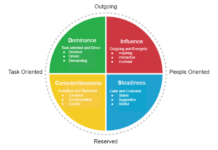
We were climbing out of the Denver International Airport on an overcast day with bumps typical of Denver. I was flying from a speaking engagement in Keystone to another one in Atlanta and was engrossed in my work when…POP! Flash! The noise and bright light came from the left wing. The response from passengers was immediate.
“Did you hear that?” “What was it?” “Did you see that flash?” Someone said, “Lightening hit the plane!” Lightening hit the plane? That can’t be good. From across the plane nervous chatter erupted. Worried thoughts flooded my mind as I thought, “Be calm. Your brain won’t function correctly unless you’re calm.” Easier said than done. And I thought, we need for the pilot to tell us what’s going on. As minutes passed (fewer than it seemed) I wondered, why isn’t the pilot talking to us? We were left in the dark.
Soon (but not soon enough), the pilot came on the speaker. Lightening had indeed hit the plane, but, not to worry, the plane is fine. And with that, he was gone. It took time for the nervous energy to settle, during which I couldn’t focus on my work.
While this is a dramatic example, we leave our staff and teams in the dark all too often. Something happens in the workplace – a new boss arrives, a big client leaves, technology melts down, there’s a personality conflict between key staff – that are the workplace equivalent of a lightning strike. The team is agitated and thinking is disrupted. Here are ways we leave our staff in the dark:
- No feedback on performance
- Limited information on company strategy
- No context for where a small task fits into the bigger picture
- No reassurance during leadership transitions or mergers
You see, uncertainty triggers the brain’s threat response. We imagine bad options before good ones. When the brain registers threat and unease, cognitive functioning is impaired and we lose productivity.
What can you do?
- Communicate what you know even if it isn’t much. You don’t know anything…you REALLY don’t know anything about the situation at hand. What’s the point of saying that? For your staff, the difference is that you KNOW you don’t know anything; they don’t. Tell them what you don’t know and give regular updates. At the federal government, every four years the administration changed. Months passed before all the leadership was in place. During that time, staff were uneasy: What would the new boss be like? My leadership team reassured staff, “We don’t know who the new boss will be or when they will arrive. But we do know that we’re doing quality work. Let’s prepare now to bring the new boss up to speed when she arrives.”
- Over-communicate. As leaders, we are exposed to information that others aren’t. We hear discussion; see emails and network with people that our staff don’t. Share what you can (without violating confidences or proprietary information) and more often than you think necessary. It will create trust, keep your staff at ease and performance at a higher level.
- Give feedback even when you’re over-whelmed or don’t think it’s necessary. Managers tell me that they’re too busy to provide feedback. Staff, on the other hand, tell me that they are left in the dark not knowing if their work is good, bad or indifferent. Don’t be that manager who, like the pilot, provides scant information. Put “give feedback” on your to-do list; set a goal to give feedback once a week.
Toward the end of the three-hour flight, the pilot returned with more information. “Planes,” he explained, “are designed to dissipate the energy from a lightning strike. The pilot and I went through the checklist and all systems are working fine.” Good to know. Wish I’d known sooner. A little knowledge would have calmed me and everyone else. And I would have been more productive because of it.
Photo copyright: Igor Zhuravlov





